Notes
The Case of The NY Times Vs. the Weiners and a Closer Look at that Times Magazine Spread
The couple deserved privacy as they worked through their problems — and they had it, until they re-emerged in public life and Mr. Weiner decided he was a good fit to run New York City. Mr. Weiner and Ms. Abedin have been saying that his sexual behavior is not the public’s business. Well, it isn’t, until they make it our business by plunging into a political campaign.
— Mr. Weiner and the Elusive Truth By THE EDITORIAL BOARD (NYT) – Published: July 23, 2013
I found it curious to read the NYT Editorial Board’s rant last week implying the public was suckered into thinking Anthony Weiner had gotten over his addiction. What the vehemence seems related to more than that, however, is the intimation on the part of The Times that they got suckered.
There was no larger marker and milestone of Weiner’s “re-emergence” than the prominent NYT Magazine cover story published on April 10th titled: “Huma & Anthony: The private life of a former power couple“ by Jonathan van Meter. If the time gap between “the re-emergence” and Weiner’s mayoral announcement on May 22 was almost six weeks, the article was nothing short of a gateway. The piece raised the prospect of a political comeback in the second paragraph and the world “mayor,” in one derivative or another, pops up 12 times.
By agreeing to be interviewed, Weiner and Abedin would seem to be trying to give voters what they want — and gauge public reaction. But it’s clear that the idea of talking about the scandal and its aftermath appeals to them on a personal level too. “We have been in a defensive crouch for so long,” Weiner said. “We are ready to clear the decks on this thing.”
If the article adopted an almost cheeky tone about Weiner’s political intentions as well as his recovery, the piece more than meets today’s standard of due diligence, celebrity politicians acknowledging their failings in a media mea culpa on the way to picking up where he or she left off. In this way, the Times got their breathy article, the public got its tabloid fix and the Weiners got to check off the re-entry box. Given the dance, the fumings of the NYT Editorial Board fundamentally overlooks their part in encouraging and relaunching Weiner into the spotlight, and their enabling role.
If you saw the Times Magazine story, though, you know it primarily dealt with the public presentation of a marriage. Here’s just one illustrative passage:
How Anthony Weiner and Huma Abedin stayed together through Weinergate is, like most negotiations between couples, deeply complicated and in some ways unknowable. “If there’s anyone who’s genetically predisposed to be able to sustain the onslaught that came from without, it’s these two,” Jason Weiner says. “Part of it is their background. They’re both political animals, let’s face it, and they can both move past the personal and be able to filter it. She was in the Clinton White House, and if there’s anyone who saw what it means to be the subject of an onslaught, be under fire, it’s her. And the two of them together have been able to survive, maybe even thrive.”
As familiar with NYT Magazine cover stories, this was as much a photo spread as a long read, and that is where I want to concentrate. Because, as much as The Times enabled the Weiners in their now-crippled return to the red carpet, what the Times also offered was actually a remarkably unremarkable grouping of photos. If the pictures on the surface capture the Weiners in the fold, their young child as the glue, a plainer and less varnished look at the images yields a more suspect and contradictory picture of marital coherence.
Take the photo of the couple working around that round table, for example. The theme, I suppose, is: bonding over work. This photo, though — as well as the others in the piece — are actually more representative of a chasm, of a disconnection and separation between the two, with Anthony (with all the incentive in the world to play it to the hilt) showing little relatedness to his wife.
To appreciate the disconnect, I’ve actually pulled each picture apart.

One thing you’ll notice is that all the personal momentos and trappings of family are stacked on Huma’s side. However, that might just be the location of the cabinet. To the extent Anthony’s problem is his runaway ego, however, what’s more interesting is how the largest photo behind Huma — larger than the one where we see her holding their child — is of Anthony.

As for the other side, what is notable for someone with an online sexting addiction — besides the bevy of technology — is the way he’s so intimately attached to that mobile. (If I’m not mistaken, it looks like there’s even another cell phone this side of the white cup, adjacent to the stack with papers on top of the red booklet with the spiral edge.
One could argue that the photo of the child behind AW, and the size of the photo, shouts of family. Perhaps, but the fact it’s just stuck there, and so aligned to his head by the photographer that it reads like a thought bubble, feels either ironic, a little contrived, or both.
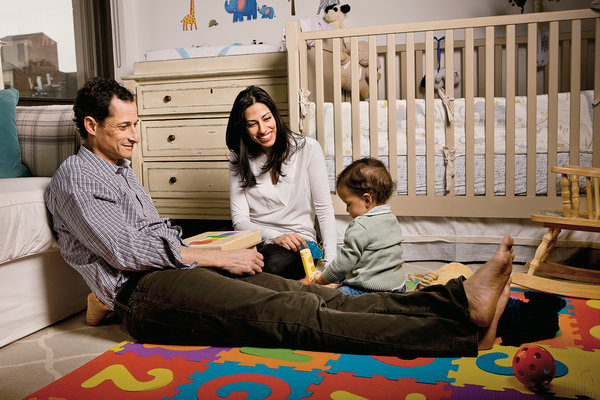
This image is the one example we are offered of the Weiners as a family unit, with Jordan as the glue. What I notice, and you can appreciate better when the photo is pulled apart, is how Weiner, with his long legs, etc., bisecting the scene, manages to both capture the foreground and and still reside at the periphery. (I’m also drawn to his proximity to the window — as if he’s as connected to what’s beyond as to who’s inside.)
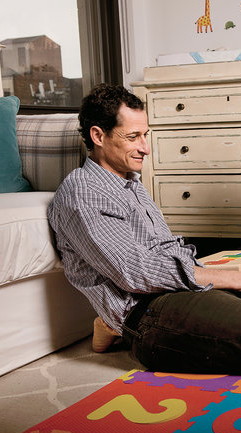
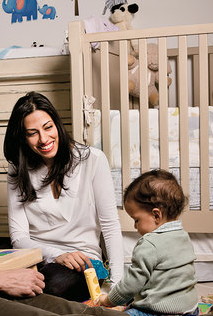
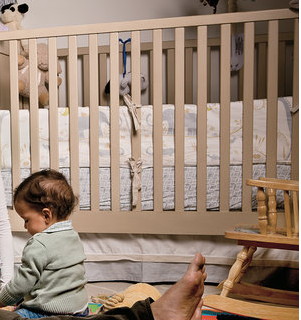
Of course, it’s harder to draw inferences because here, for the only time in the edit, he has eyes for another person. But how much actual intimacy does the photo convey, the couple only connected through the act of spectatorship?
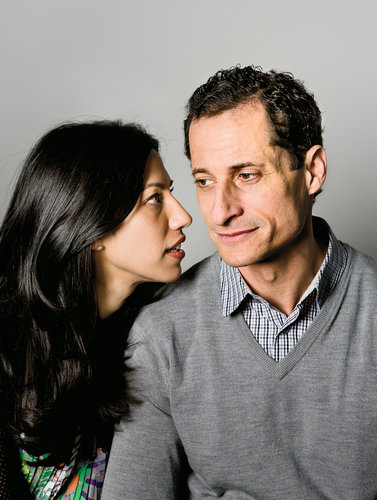
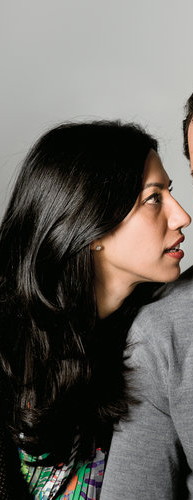
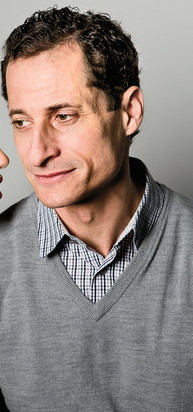
And then, this is simply cringe-worthy, that shot where the wife’s devotion is truly blind while Anthony is captured as the icon, as a figure of such imagined importance that he’s got deeper things to attend to. I imagine, though, it’s part of the editor’s calculus where this picture of spousal blindness is offset with the cover shot’s quality of retribution.
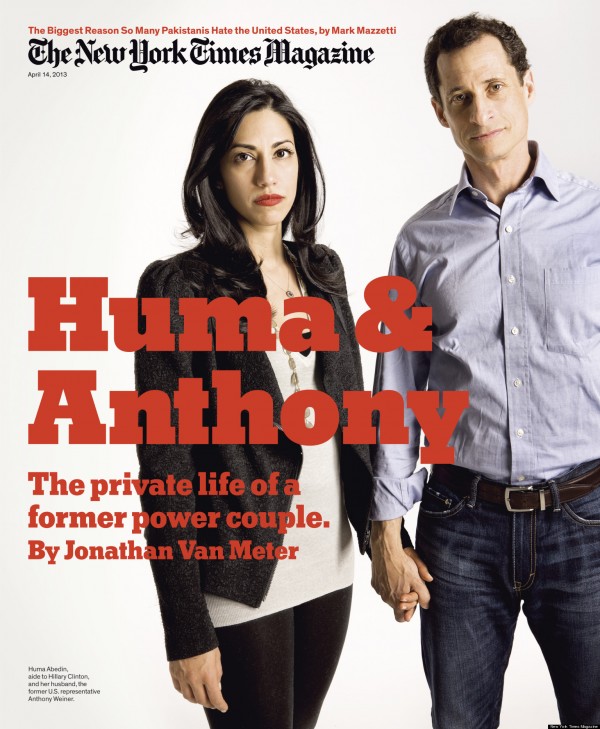
Of course, it would be nonsensical if Huma wasn’t captured, at least in part, as aggrieved. With the couple aiming to put their best face forward for the re-entry, however, this is quite a slam. If the Magazine was giving credence to the couple’s effort at all, you’d imagine the cover as slightly more harmonious with the fractures reserved for an inside page.
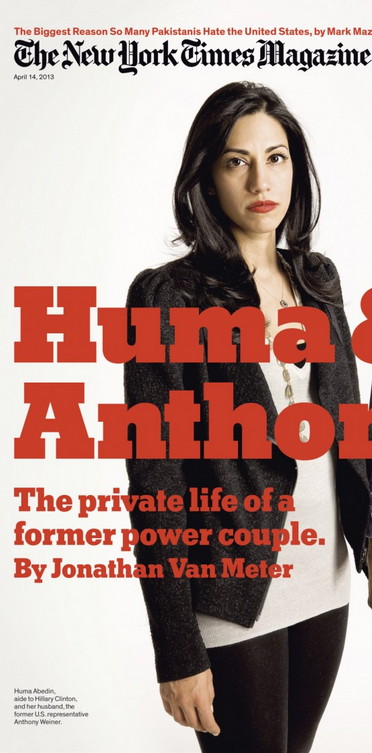

Instead, though I can’t say they don’t deserve it, these painfully separate figures are being played for fools.
Maybe for the plaintive and marginalized Anthony — this being the only photo in the set where he’s seen to be touching anybody — his attachment to Huma before the public eye is what allows him to still have us largely to himself. As for the Huma’s supposedly put-out but just as pitiable look, the page designer loading her down with those red-badged letters, we see her buried under the weight of who and how big they are supposed to be.
(photos: Elinor Carucci/Redux, for The New York Times)



Reactions
Comments Powered by Disqus